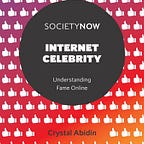What makes an internet celebrity, an internet celebrity?
Happy Monday readers!
For those of you who didn’t catch my previous post, I am writing a series of blogs to critically discuss Crystal Abidin’s book, ‘Internet Celebrity: Understanding Fame Online’.
In this post I am going to discuss Abidin’s line of argument about the traits that make a successful influencer, whilst drawing on some examples that I have seen on my travels across the web in the past few years.
Abidin argues that celebrities are praised for ‘exclusivity, exoticism, exceptionalism and everydayness’ (Abidin, 2018, pg. 19). She deconstructs this for us and notes that draws on Pierre Bourdieu’s ideas on how capital is gained within society (Bourdieu, 1986).
Everydayness is integral to the success of an influencer. It makes them relatable, trustworthy and likeable to us ‘normal people’. This is perfectly exemplified by the phenomenon ‘vlogging’. By simply filming themselves going about their day with their friends, these videos gain millions of views. Someone who has made an empire out of this has been mother of two Louise Pentland, AKA ‘Sprinkle of Glitter’ on YouTube. Her ‘mummy’ vlogs or ‘sharenting’ (Blumm-Ross & Livingstone, 2017), feature the rawest moments of motherhood, unfiltered and laid bare to her viewers- she even videoed herself giving birth! Nugraha’s findings suggest that vlogging provides greater brand awareness through seeming more credible and passionate in an informal and chatty set-up (Nugraha, 2018). Again, this makes the vlogger very attractive to advertisers; they have a readily available and trusting audience to promote their products to, provided by the influencer.
Under ‘web 2.0’ (O,Reilly, 2009), people are much less likely to be passive consumers of the content they see online. Users become ‘prosumers’ (Kotler, 2010), whereby they can actively participate in creating content such as commenting and voting in polls. Oftentimes, the influencers interact with their fans in the comment section, reducing the distance between the audience and the celebrity. This is more appealing to audiences as they feel connected to the influencer through relatability as well as interaction. I would argue that this is even more important for audiences during the current pandemic with COVID-19. With millions in isolation, vlogging may be a great way for the creator to vent their feelings and for the viewer to know that they are not alone in how they are feeling and therefore feel connected to their content.
Exclusivity inherently lends itself to the idea of privilege and wealth and therefore the image of ‘celebrity’. Abidin makes this link seamlessly when discussing the ‘rich kids of Instagram’ or ‘RKOI’. For many internet celebrities, the only trait that divides them from the general public, is the wealth they have gained. Beauty influencers exclusively are ‘gifted’ unreleased products by brands, and in return, they promote and review these products to their thousands of trusting followers (Smith, Kendall, Knighton & Wright, 2018). Makeup and beauty fans see these products like gold dust because they cannot yet access them. Not only does this allow viewers to make an informed decision on their purchases, but the brands generate hype and anticipation for their launches before releasing them to eager customers.
That’s all from me today… have a good one!
PurpleBlogs :)
References
Abidin, C. (2018). Internet celebrity. Bingley: Emerald Publishing.
Blum-Ross, A., & Livingstone, S. (2017). “Sharenting,” parent blogging, and the boundaries of the digital self. Popular Communication, 15(2), 110–125.
Bourdieu, P. (1986). The forms of capital.
Kotler, P. (2010). The prosumer movement. In Prosumer Revisited (pp. 51–60). VS Verlag für Sozialwissenschaften.
NUGRAHA, A. (2018). The Effects of Vlogger Credibility as Marketing Media on Brand Awareness to Customer Purchase Intention (Study on Traveloka With Arief Muhammad as a Vlogger on Youtube) (Doctoral dissertation, Universitas Jenderal Soedirman).
O’reilly, T. (2009). What is web 2.0. “ O’Reilly Media, Inc.”.
Smith, B. G., Kendall, M. C., Knighton, D., & Wright, T. (2018). Rise of the brand ambassador: social stake, corporate social responsibility and influence among the social media influencers. Communication Management Review, 3(01), 6–29.
